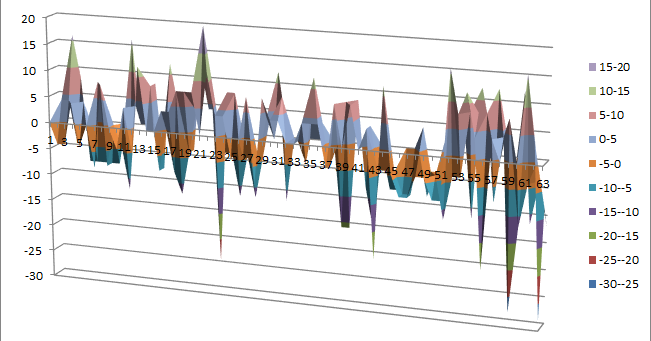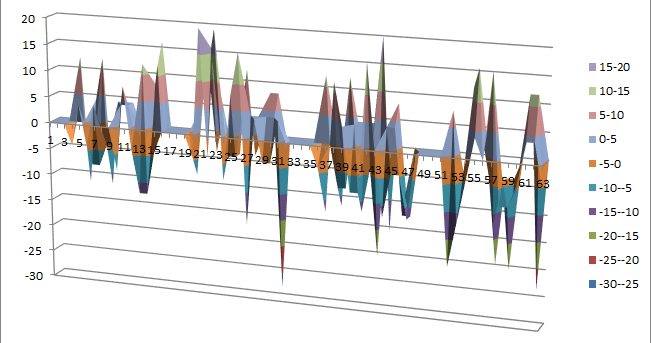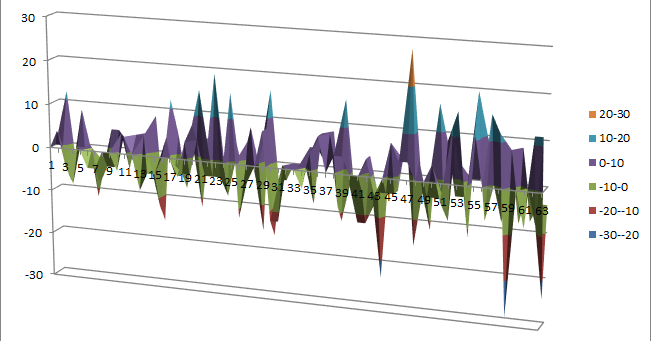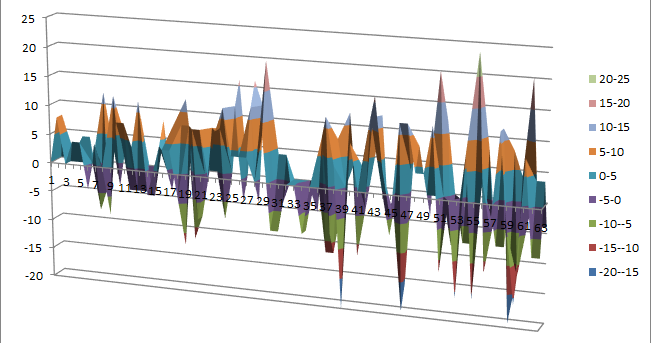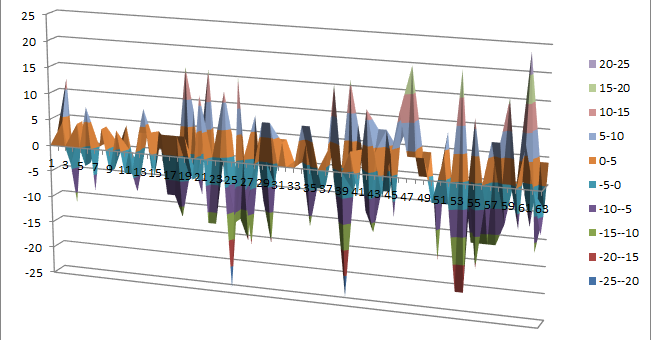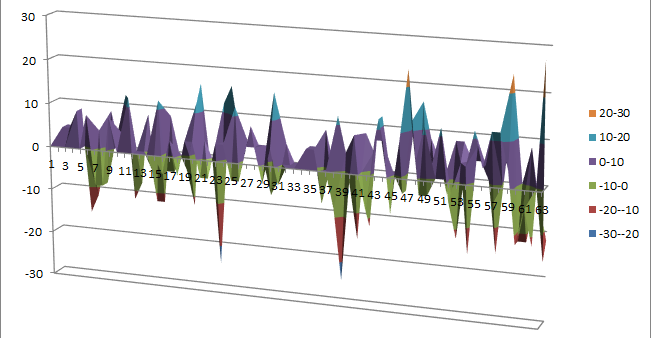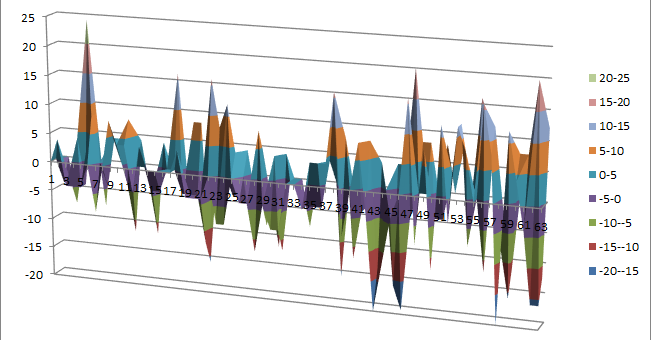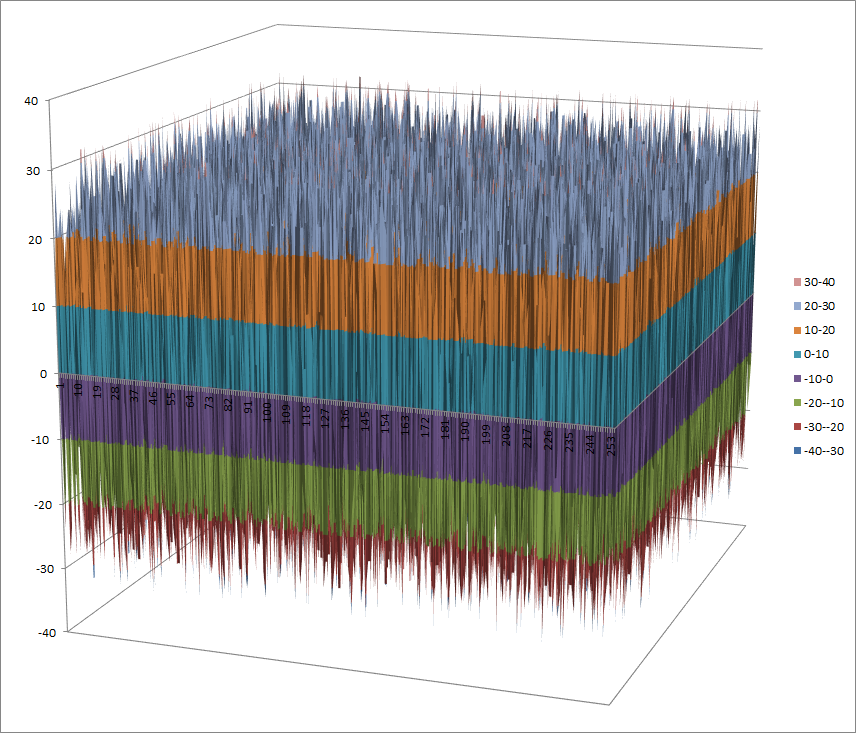10. Analysis of other cryptographic algorithms¶
There are some block ciphers that are relevant either because its wide use or because of its importance in the development of cryptanalysis techniques. In this chapter, some cryptographic algorithms from other block ciphers are analysed.
Below you can find a legend describing the cryptographic criteria used in this chapter:
| NL | Nonlinearity |
| NL2 | 2-nd order nonlinearity |
| LD | Linearity distance |
| DEG | Algebraic degree |
| AI | Algebraic immunity |
| MAXAC | Absolute indicator |
 |
Sum-of-squares indicator |
| LP | Linear potential |
| DP | Differential Potential |
Hyperlinks to representations
Open the hyperlinks to representations below in a new browser window or in a new tab.
10.1. DES¶
10.1.1. Description¶
DES is a block cipher used for securing sensitive but unclassified material by U.S. Government agencies and became the de facto encryption standard for commercial transactions in the private sector up to December 6, 2001. It was superseded by AES. DES has eight 6x4 S-boxes: S1, S2, S3, S4, S5, S6, S7, S8.
10.1.2. Summary¶
| S-box | NL | NL2 | LD | DEG | AI | MAXAC |  |
LP | DP |
|---|---|---|---|---|---|---|---|---|---|
| S1 | 14 | 8 | 4 | 4 | 2 | 48 | 36736 | 0.31640625 | 0.25 |
| S2 | 16 | 10 | 2 | 4 | 3 | 56 | 25984 | 0.25 | 0.25 |
| S3 | 16 | 10 | 4 | 4 | 3 | 48 | 24064 | 0.25 | 0.25 |
| S4 | 16 | 8 | 0 | 3 | 2 | 64 | 40960 | 0.25 | 0.25 |
| S5 | 12 | 10 | 6 | 4 | 2 | 40 | 47104 | 0.390625 | 0.25 |
| S6 | 18 | 10 | 4 | 5 | 3 | 48 | 19456 | 0.19140625 | 0.25 |
| S7 | 14 | 10 | 4 | 5 | 3 | 48 | 34048 | 0.31640625 | 0.25 |
| S8 | 16 | 10 | 4 | 4 | 3 | 48 | 24064 | 0.25 | 0.25 |
10.1.3. S1¶
10.1.3.1. Representations¶
Polynomial representation in ANF
Walsh Spectrum representation (except first row and column):
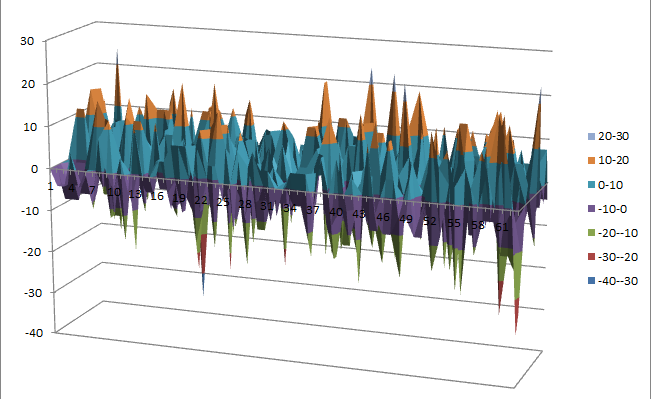
10.1.3.2. Other useful information in cryptanalysis¶
There are no linear structures
10.1.4. S2¶
10.1.4.1. Representations¶
Polynomial representation in ANF
Walsh Spectrum representation (except first row and column):
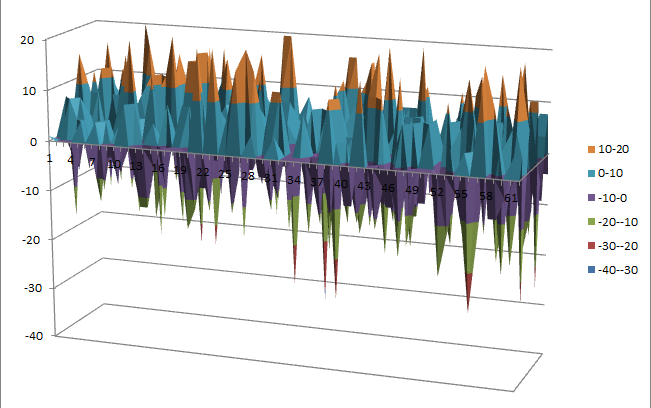
10.1.4.2. Other useful information in cryptanalysis¶
There are no linear structures
10.1.5. S3¶
10.1.5.1. Representations¶
Polynomial representation in ANF
Walsh Spectrum representation (except first row and column):
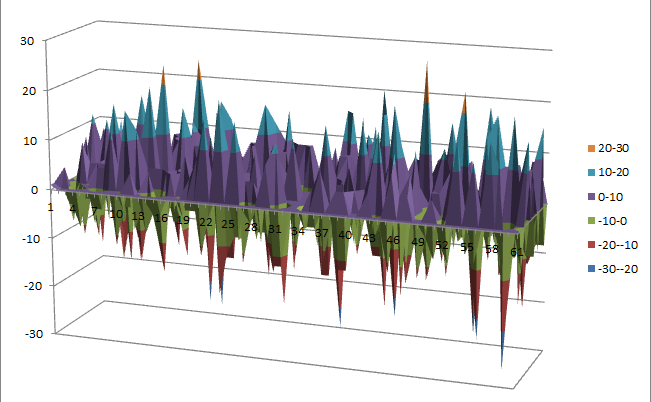
10.1.5.2. Other useful information in cryptanalysis¶
There are no linear structures
10.1.6. S4¶
10.1.6.1. Representations¶
Polynomial representation in ANF
Walsh Spectrum representation (except first row and column):
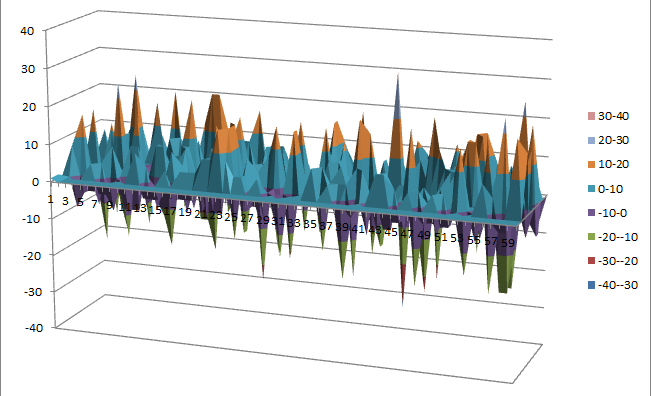
10.1.6.2. Other useful information in cryptanalysis¶
There are 9 linear structures:
([0 0 0 0 0 1],[0 0 1 1])
([0 0 0 0 0 1],[1 1 0 0])
([0 0 0 0 0 1],[1 1 1 1])
([1 0 1 1 1 0],[0 1 0 1])
([1 0 1 1 1 0],[1 0 1 0])
([1 0 1 1 1 0],[1 1 1 1])
([1 0 1 1 1 1],[0 1 1 0])
([1 0 1 1 1 1],[1 0 0 1])
([1 0 1 1 1 1],[1 1 1 1])
10.1.7. S5¶
10.1.7.1. Representations¶
Polynomial representation in ANF
Walsh Spectrum representation (except first row and column):
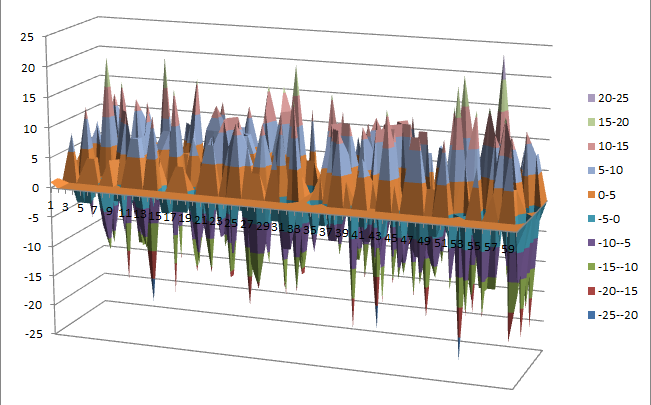
10.1.7.2. Other useful information in cryptanalysis¶
There are no linear structures
10.1.8. S6¶
10.1.8.1. Representations¶
Polynomial representation in ANF
Walsh Spectrum representation (except first row and column):
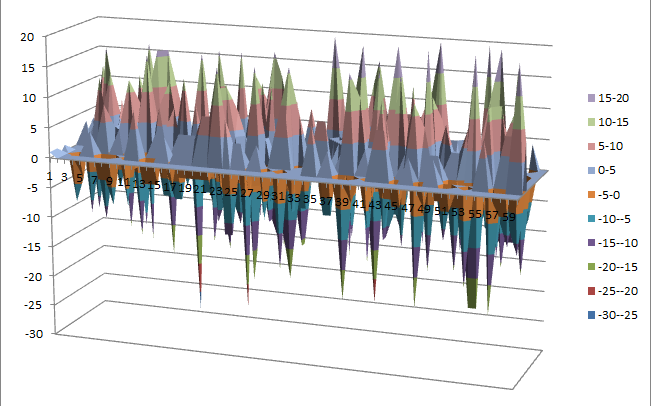
10.1.8.2. Other useful information in cryptanalysis¶
There are no linear structures
10.1.9. S7¶
10.1.9.1. Representations¶
Polynomial representation in ANF
Walsh Spectrum representation (except first row and column):
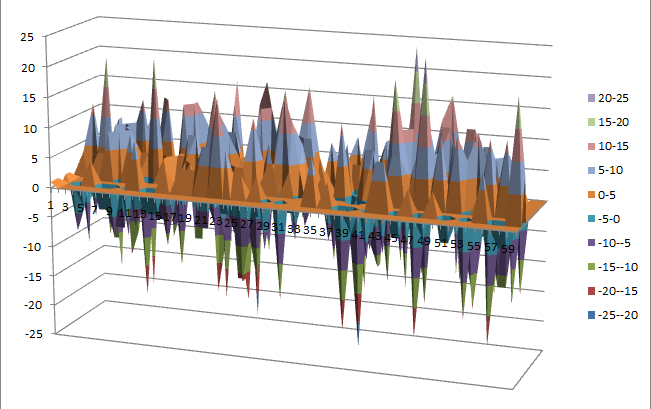
10.1.9.2. Other useful information in cryptanalysis¶
There are no linear structures
10.1.10. S8¶
10.1.10.1. Representations¶
Polynomial representation in ANF
Walsh Spectrum representation (except first row and column):
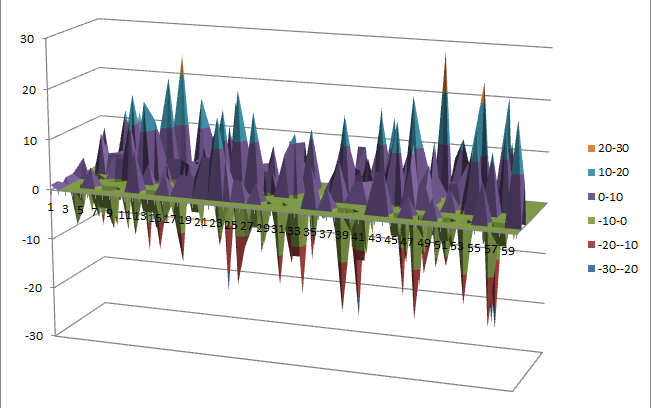
10.1.10.2. Other useful information in cryptanalysis¶
There are no linear structures
10.2. KASUMI¶
10.2.1. Description¶
KASUMI is a block cipher used in UMTS, GSM, and GPRS mobile communications systems. UMTS uses KASUMI in the confidentiality (f8) and integrity algorithms (f9) named UEA1 and UIA1, respectively. GSM employs KASUMI in the A5/3 key stream generator whereas GPRS does so in the GEA3 key stream generator. This cipher has two S-boxes: a 7x7 S-box called S7 and a 9x9 S-box called S9.
10.2.2. Summary¶
| S-box | size | NL | NL2 | LD | DEG | AI | MAXAC |  |
LP | DP |
|---|---|---|---|---|---|---|---|---|---|---|
| S7 | 7x7 | 56 | 36 | 28 | 3 | 3 | 16 | 32768 | 0.015625 | 0.015625 |
| S9 | 9x9 | 240 | 0 | 0 | 2 | 2 | 512 | 524288 | 0.00390625 | 0.00390625 |
10.2.3. S7¶
10.2.3.1. Representations¶
Polynomial representation in ANF
Walsh Spectrum representation (except first row and column):
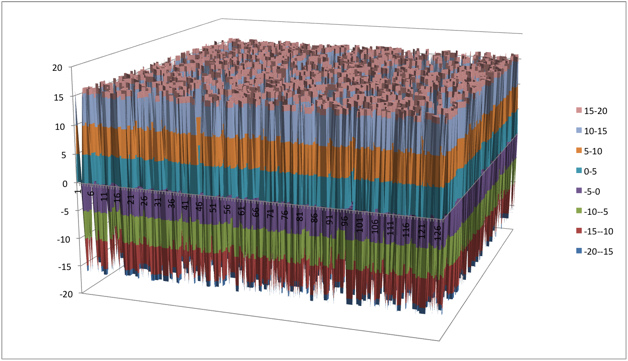
10.2.3.2. Other useful information in cryptanalysis¶
Cycle structure:
| Cycle length | Number of cycles |
|---|---|
| 1 | 1 |
| 13 | 1 |
| 22 | 1 |
| 92 | 1 |
There are no linear structures
It has 1 fixed point: (0,0,1,1,0,1,1)
It has no negated fixed points
10.2.4. S9¶
10.2.4.1. Representations¶
10.2.4.2. Other useful information in cryptanalysis¶
Cycle structure:
| Cycle length | Number of cycles |
|---|---|
| 1 | 2 |
| 2 | 1 |
| 12 | 1 |
| 26 | 1 |
| 74 | 1 |
| 121 | 1 |
| 275 | 1 |
There are 511 linear structures:
It has 1 fixed point: (0,1,0,0,1,0,1,1,1)
It has 1 negated fixed points (1,0,0,0,1,1,0,0,0)
10.2.5. FI¶
Algebraic degree from key 00000 to 65535
Cycle structure from key 00000 to 65535
Fixed and negated points from key 00000 to 65535
Nonlinearities from key 00000 to 65535
Graphical display of the distribution of the nonlinearities of FI:
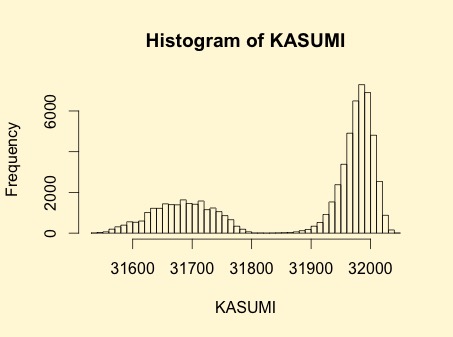
| Descriptive Statistics of FI nonlinearities | |
|---|---|
| Unique Values | 478 |
| Min | 31534 |
| Max | 32049 |
| Mean | 31878.7986 |
| Mean Deviation | 132.083019 |
| 1st Quartile | 31720 |
| Median | 31963 |
| 3rd Quartile | 31989 |
| Mode | 31995 |
| Range | 515 |
| Variance | 20879.009 |
| Standard Deviation | 144.4957 |
| Kkewness | -0.7622 |
| Kurtosis | -1.1463 |
| P0.5 | 31572 |
| P1 | 31582 |
| P5 | 31627 |
| P95 | 32011 |
| P99 | 32023 |
| P99.5 | 32027 |
10.3. MacGuffin¶
10.3.1. Description¶
MacGuffin is a block cipher uses a F-function which consists of the 8 S-boxes of the DES, but the two middle output bits of each S-box are neglected in order to obtain a 16-bit output. MacGuffin has eight 6x2 S-boxes: S1, S2, S3, S4, S5, S6, S7, S8.
10.3.2. Summary¶
| S-box | NL | NL2 | LD | DEG | AI | MAXAC |  |
LP | DP |
|---|---|---|---|---|---|---|---|---|---|
| S1 | 18 | 12 | 8 | 5 | 3 | 32 | 20224 | 0.19140625 | 0.53125 |
| S2 | 18 | 10 | 6 | 5 | 3 | 40 | 19840 | 0.19140625 | 0.5625 |
| S3 | 18 | 10 | 4 | 5 | 3 | 48 | 21376 | 0.19140625 | 0.53125 |
| S4 | 16 | 8 | 0 | 4 | 2 | 64 | 25600 | 0.25 | 0.5 |
| S5 | 20 | 12 | 8 | 5 | 3 | 32 | 16000 | 0.140625 | 0.5 |
| S6 | 20 | 10 | 4 | 5 | 3 | 48 | 19456 | 0.140625 | 0.4375 |
| S7 | 18 | 10 | 4 | 5 | 3 | 48 | 23296 | 0.19140625 | 0.53125 |
| S8 | 20 | 10 | 6 | 5 | 3 | 40 | 14848 | 0.140625 | 0.5 |
10.3.3. S1¶
10.3.3.2. Other useful information in cryptanalysis¶
There are no linear structures
10.3.4. S2¶
10.3.4.2. Other useful information in cryptanalysis¶
There are no linear structures
10.3.5. S3¶
10.3.5.2. Other useful information in cryptanalysis¶
There are no linear structures
10.3.6. S4¶
10.3.6.2. Other useful information in cryptanalysis¶
There are 1 linear structure:
([1 0 1 1 1 1],[1 1])
10.3.7. S5¶
10.3.7.2. Other useful information in cryptanalysis¶
There are no linear structures
10.3.8. S6¶
10.3.8.2. Other useful information in cryptanalysis¶
There are no linear structures
10.3.9. S7¶
10.3.9.2. Other useful information in cryptanalysis¶
There are no linear structures
10.3.10. S8¶
10.3.10.2. Other useful information in cryptanalysis¶
There are no linear structures
10.4. Mini-AES¶
10.4.1. Description¶
Raphael Chung-Wei Phan presented a version of the AES [Phan02miniadvanced], with all the parameters significantly reduced while preserving its original structure. This Mini version is purely educational and is designed to grasp the underlying concepts of Rijndael-like ciphers. It may also serve as a testbed for starting cryptanalysts to experiment with various cryptanalytic attacks. The Mini-AES cipher is a  vector Boolean function and the Mini-AES encryption is performed with a secret key of 16 bits.
vector Boolean function and the Mini-AES encryption is performed with a secret key of 16 bits.
The Mini-AES S-box is called NibbleSub, and defines a simple operation that substitutes each input with an output according to a 4x4 substitution table (S-box) given in the table below. These values are, in fact, taken from the first row of the first S-box in DES.
| NibbleSub Truth Table | |
|---|---|
| Input | Output |
| 0000 | 1110 |
| 0001 | 0100 |
| 0010 | 1101 |
| 0011 | 0001 |
| 0100 | 0010 |
| 0101 | 1111 |
| 0110 | 1011 |
| 0111 | 1000 |
| 1000 | 0011 |
| 1001 | 1010 |
| 1010 | 0110 |
| 1011 | 1100 |
| 1100 | 0101 |
| 1101 | 1001 |
| 1110 | 0000 |
| 1111 | 0111 |
The inverse of the previous table is easily computed by interchanging the input nibble with the output nibble, and then resorting it based on the new input nibble, as given in the table below.
| NibbleSubInv Truth Table | |
|---|---|
| Input | Output |
| 0000 | 1110 |
| 0001 | 0011 |
| 0010 | 0100 |
| 0011 | 1000 |
| 0100 | 0001 |
| 0101 | 1100 |
| 0110 | 1010 |
| 0111 | 1111 |
| 1000 | 0111 |
| 1001 | 1101 |
| 1010 | 1001 |
| 1011 | 0110 |
| 1100 | 1011 |
| 1101 | 0010 |
| 1110 | 0000 |
| 1111 | 0101 |
10.4.2. Summary¶
| S-box | size | NL | NL2 | LD | DEG | AI | MAXAC |  |
LP | DP |
|---|---|---|---|---|---|---|---|---|---|---|
| NibbleSub | 4x4 | 2 | 0 | 0 | 2 | 2 | 16 | 1408 | 0.5625 | 0.5 |
| NibbleSubInv | 4x4 | 2 | 0 | 0 | 2 | 2 | 16 | 11408 | 0.5625 | 0.5 |
| MixColumn | 8x8 | 0 | 0 | 1 | 1 | 256 | 16777216 | 1 | 1 |
10.4.3. NibbleSub¶
10.4.3.1. Representations¶
Polynomial representation in ANF
| 16 | 0 | 0 | 0 | 0 | 0 | 0 | 0 | 0 | 0 | 0 | 0 | 0 | 0 | 0 | 0 |
| 0 | 0 | -4 | -4 | 0 | 0 | -4 | 12 | 4 | 4 | 0 | 0 | 4 | 4 | 0 | 0 |
| 0 | 0 | -4 | -4 | 0 | 0 | -4 | -4 | 0 | 0 | 4 | 4 | 0 | 0 | -12 | 4 |
| 0 | 0 | 0 | 0 | 0 | 0 | 0 | 0 | 4 | -12 | -4 | -4 | 4 | 4 | -4 | -4 |
| 0 | 4 | 0 | -4 | -4 | -8 | -4 | 0 | 0 | -4 | 0 | 4 | 4 | -8 | 4 | 0 |
| 0 | -4 | -4 | 0 | -4 | 0 | 8 | 4 | -4 | 0 | -8 | 4 | 0 | -4 | -4 | 0 |
| 0 | 4 | -4 | 8 | 4 | 0 | 0 | 4 | 0 | -4 | 4 | 8 | -4 | 0 | 0 | -4 |
| 0 | -4 | 0 | 4 | 4 | -8 | 4 | 0 | -4 | 0 | 4 | 0 | 8 | 4 | 0 | 4 |
| 0 | 0 | 0 | 0 | 0 | 0 | 0 | 0 | -4 | 4 | 4 | -4 | 4 | -4 | -4 | -12 |
| 0 | 0 | -4 | -4 | 0 | 0 | -4 | -4 | -8 | 0 | -4 | 4 | 0 | 8 | 4 | -4 |
| 0 | 8 | -4 | 4 | -8 | 0 | 4 | -4 | 4 | 4 | 0 | 0 | 4 | 4 | 0 | 0 |
| 0 | 8 | 0 | -8 | 8 | 0 | 8 | 0 | 0 | 0 | 0 | 0 | 0 | 0 | 0 | 0 |
| 0 | -4 | 8 | -4 | -4 | 0 | 4 | 0 | 4 | 0 | 4 | 8 | 0 | 4 | 0 | -4 |
| 0 | 4 | 4 | 0 | -4 | 8 | 0 | 4 | -8 | -4 | 4 | 0 | 4 | 0 | 0 | 4 |
| 0 | 4 | 4 | 0 | -4 | -8 | 0 | 4 | -4 | 0 | 0 | -4 | -8 | 4 | -4 | 0 |
| 0 | -4 | -8 | -4 | -4 | 0 | 4 | 0 | 0 | -4 | 8 | -4 | -4 | 0 | 4 | 0 |
Walsh Spectrum representation (except first row and column):
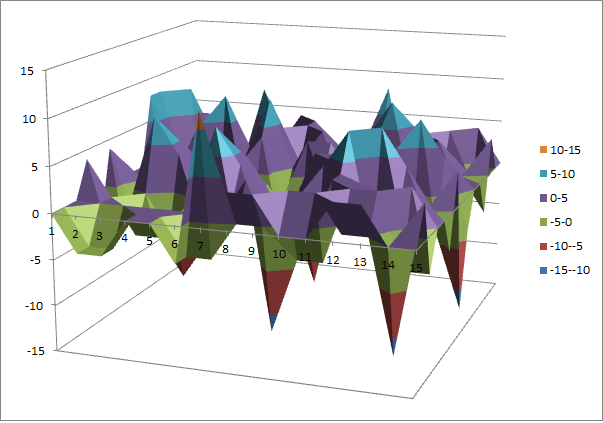
10.4.3.2. Other useful information in cryptanalysis¶
Cycle structure:
| Cycle length | Number of cycles |
|---|---|
| 2 | 1 |
| 14 | 1 |
There are 7 linear structures:
([0 0 1 1],[0 1 1 1])
([0 1 0 0],[0 1 0 1])
([1 0 1 0],[1 1 1 1])
([1 0 1 1],[0 1 0 1])
([1 1 0 1],[1 0 0 1])
([1 1 1 0],[1 1 1 0])
([1 1 1 1],[0 1 0 1])
It has no fixed points and 2 negated fixed points: (0,0,1,0), (0,1,1,1)
10.4.4. NibbleSubInv¶
10.4.4.1. Representations¶
Polynomial representation in ANF
| 16 | 0 | 0 | 0 | 0 | 0 | 0 | 0 | 0 | 0 | 0 | 0 | 0 | 0 | 0 | 0 |
| 0 | 0 | 0 | 0 | 4 | -4 | 4 | -4 | 0 | 0 | 8 | 8 | -4 | 4 | 4 | -4 |
| 0 | -4 | -4 | 0 | 0 | -4 | -4 | 0 | 0 | -4 | -4 | 0 | 8 | 4 | 4 | -8 |
| 0 | -4 | -4 | 0 | -4 | 0 | 8 | 4 | 0 | -4 | 4 | -8 | -4 | 0 | 0 | -4 |
| 0 | 0 | 0 | 0 | -4 | -4 | 4 | 4 | 0 | 0 | -8 | 8 | -4 | -4 | -4 | -4 |
| 0 | 0 | 0 | 0 | -8 | 0 | 0 | -8 | 0 | 0 | 0 | 0 | 0 | 8 | -8 | 0 |
| 0 | -4 | -4 | 0 | -4 | 8 | 0 | 4 | 0 | -4 | 4 | 8 | 4 | 0 | 0 | 4 |
| 0 | 12 | -4 | 0 | 0 | 4 | 4 | 0 | 0 | -4 | -4 | 0 | 0 | 4 | 4 | 0 |
| 0 | 4 | 0 | 4 | 0 | -4 | 0 | -4 | -4 | -8 | 4 | 0 | 4 | -8 | -4 | 0 |
| 0 | 4 | 0 | -12 | -4 | 0 | -4 | 0 | 4 | 0 | 4 | 0 | 0 | -4 | 0 | -4 |
| 0 | 0 | 4 | -4 | 0 | -8 | 4 | 4 | 4 | -4 | 0 | 0 | 4 | 4 | 0 | 8 |
| 0 | 0 | 4 | -4 | 4 | 4 | 8 | 0 | -4 | 4 | 0 | 0 | 8 | 0 | -4 | -4 |
| 0 | 4 | 0 | 4 | 4 | 0 | -4 | 8 | 4 | 0 | 4 | 0 | 0 | 4 | -8 | -4 |
| 0 | 4 | 0 | 4 | -8 | -4 | 0 | 4 | -4 | 8 | 4 | 0 | 4 | 0 | 4 | 0 |
| 0 | 0 | -12 | -4 | 4 | -4 | 0 | 0 | -4 | 4 | 0 | 0 | 0 | 0 | -4 | 4 |
| 0 | 0 | 4 | -4 | 0 | 0 | -4 | 4 | -12 | -4 | 0 | 0 | -4 |4 |0 | 0 | ||
Walsh Spectrum representation (except first row and column):
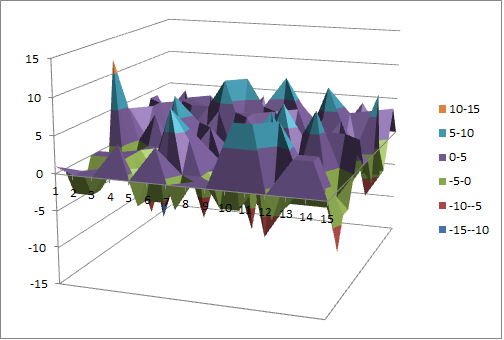
10.4.4.2. Other useful information in cryptanalysis¶
Cycle structure:
| Cycle length | Number of cycles |
|---|---|
| 2 | 1 |
| 14 | 1 |
There are 7 linear structures:
([0 0 1 0],[0 0 1 0])
([0 1 0 1],[1 0 1 1])
([1 0 0 0],[0 0 1 1])
([1 0 0 0],[1 0 0 0])
([1 0 0 0],[1 0 1 1])
([1 0 1 0],[0 0 0 1])
([1 1 0 1],[1 0 1 1])
It has no fixed points and 2 negated fixed points: (1,0,0,0), (1,1,0,1)
10.4.5. MixColumn¶
10.4.5.1. Representations¶
Polynomial representation in ANF
Walsh Spectrum representation (except first row and column):
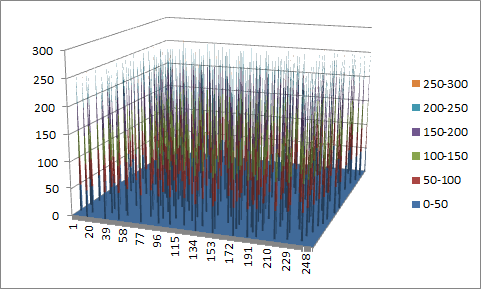
10.4.5.2. Other useful information in cryptanalysis¶
Cycle structure:
| Cycle length | Number of cycles |
|---|---|
| 1 | 16 |
| 2 | 120 |
There 65025 linear structures
It has 15 fixed points: (0,0,0,0,0,0,0,0), (0,0,0,1,0,0,0,1), (0,0,1,0,0,0,1,0), (0,0,1,1,0,0,1,1), (0,1,0,0,0,1,0,0), (0,1,0,1,0,1,0,1), (0,1,1,0,0,1,1,0), (0,1,1,1,0,1,1,1), (1,0,0,0,1,0,0,0), (1,0,0,1,1,0,0,1), (1,0,1,0,1,0,1,0), (1,0,1,1,1,0,1,1), (1,1,0,0,1,1,0,0), (1,1,0,1,1,1,0,1), (1,1,1,0,1,1,1,0)
It has 16 negated fixed points: (0,0,0,0,1,1,1,0), (0,0,0,1,1,1,1,1), (0,0,1,0,1,1,0,0), (0,0,1,1,1,1,0,1), (0,1,0,0,1,0,1,0), (0,1,0,1,1,0,1,1), (0,1,1,0,1,0,0,0), (0,1,1,1,1,0,0,1), (1,0,0,0,0,1,1,0), (1,0,0,1,0,1,1,1), (1,0,1,0,0,1,0,0), (1,0,1,1,0,1,0,1), (1,1,0,0,0,0,1,0), (1,1,0,1,0,0,1,1), (1,1,1,0,0,0,0,0), (1,1,1,1,0,0,0,1)
10.4.6. ks0¶
10.4.6.1. Representations¶
Polynomial representation in ANF
Walsh Spectrum (each row represents a column of Walsh Spectrum)
Linear Profile (each row represents a column of Linear Profile)
10.4.6.2. Other useful information in cryptanalysis¶
Cycle structure:
| Cycle length | Number of cycles |
|---|---|
| 1 | 65536 |
10.4.7. ks1¶
10.4.7.1. Representations¶
Polynomial representation in ANF
Walsh Spectrum (each row represents a column of Walsh Spectrum)
Linear Profile (each row represents a column of Linear Profile)
10.4.7.2. Other useful information in cryptanalysis¶
Cycle structure:
| Cycle length | Number of cycles |
|---|---|
| 1 | 1 |
| 5 | 2 |
| 10 | 2 |
| 28 | 1 |
| 60 | 1 |
| 1223 | 1 |
| 26097 | 1 |
| 38097 | 1 |
10.4.8. ks2¶
10.4.8.1. Representations¶
Polynomial representation in ANF:
Walsh Spectrum (each row represents a column of Walsh Spectrum)
Linear Profile (each row represents a column of Linear Profile)
10.4.8.2. Other useful information in cryptanalysis¶
Cycle structure:
| Cycle length | Number of cycles |
|---|---|
| 1 | 1 |
| 12 | 1 |
| 15 | 3 |
| 30 | 1 |
| 109 | 1 |
| 385 | 1 |
| 831 | 1 |
| 2472 | 1 |
| 3617 | 1 |
| 9775 | 1 |
| 16777 | 1 |
| 31482 | 1 |
10.4.9. mini-AES¶
Algebraic degree from key 00000 to 65535 is equal to 14
Cycle structure from key 00000 to 65535
Fixed and negated points from key 00000 to 65535
Nonlinearities from key 00000 to 65535
Nonlinearities in ascendent order
Graphical display of the distribution of the nonlinearities of mini-AES:
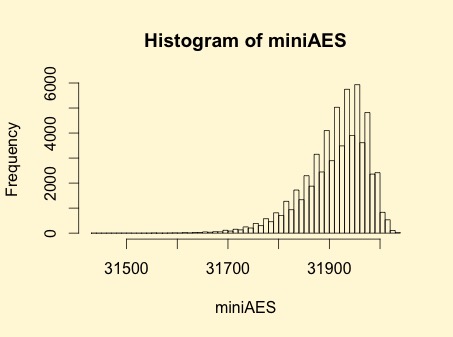
| Descriptive Statistics of mini-AES nonlinearities | |
|---|---|
| Unique Values | 130 |
| Min | 31432 |
| Max | 32040 |
| Mean | 31912.9894 |
| Mean Deviation | 8.6571 |
| 1st Quartile | 31880 |
| Median | 31924 |
| 3rd Quartile | 31960 |
| Mode | 31952 |
| Range | 608 |
| Variance | 3903.8642 |
| Standard Deviation | 62.4809 |
| Kkewness | -1.092059 |
| Kurtosis | 1.79284 |
| P0.5 | 31692 |
| P1 | 31720 |
| P5 | 31796 |
| P95 | 31992 |
| P99 | 32012 |
| P99.5 | 32016 |
10.5. Square¶
10.5.1. Description¶
Square is a block cipher invented by Joan Daemen and Vincent Rijmen. The design, published in 1997, is a forerunner to Rijndael, which has been adopted as the Advanced Encryption Standard. It has a 8x8 S-box called S.
10.5.2. Summary¶
| S-box | size | NL | LD | DEG | AI | MAXAC |  |
LP | DP |
|---|---|---|---|---|---|---|---|---|---|
| S | 8x8 | 112 | 56 | 7 | 4 | 32 | 133120 | 0.015625 | 0.015625 |
10.5.3. S¶
10.5.3.2. Other useful information in cryptanalysis¶
Cycle structure:
| Cycle length | Number of cycles |
|---|---|
| 1 | 2 |
| 6 | 1 |
| 8 | 1 |
| 20 | 1 |
| 23 | 1 |
| 197 | 1 |
There are no linear structures
It has 1 fixed point: (0,0,0,0,1,1,0,0)
It has 1 negated fixed point: (1,0,0,1,0,1,1,1)
